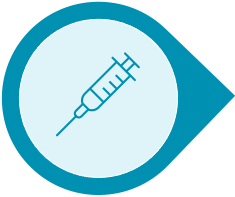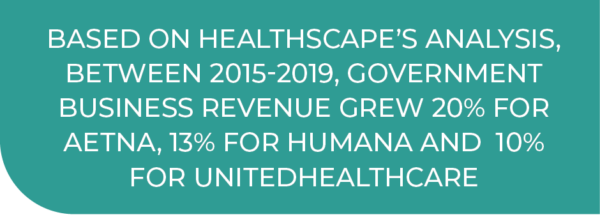
2021 Health Plan Priorities: Pressing Past the Pandemic
2020 has redefined healthcare in a way no one could have predicted. The US healthcare system finds itself looking at an uncertain future in which healthcare, namely COVID-19, has manifested itself in nearly every aspect of life. The impact of COVID-19 has induced dramatic changes to the healthcare system which have altered the course of nearly every organization in the industry as cases continue to rise to 25.1 million total cases and over 419K deaths as of the writing of this brief.
While there appears to be a light at the end of the tunnel with the approval of two vaccines and roll-out to front line healthcare workers and vulnerable populations, it is expected that the impacts of COVID-19 will continue into 2021. And while the vaccines represent an end to the darkest chapters of the pandemic, uncertainty still exists with respect to how long full recovery will take and the impacts of a new administration governing in a deeply divided political climate.
HealthScape Advisors cannot hold a crystal ball to the future; however, our engagements and relationships with our clients across the country have provided us foresight into health plan priorities in the coming year. This Executive Brief will provide our top five health plan priorities for 2021:
 DRIVING GROWTH THROUGH GOVERNMENT PROGRAMS
DRIVING GROWTH THROUGH GOVERNMENT PROGRAMS
 RE-IGNITING INNOVATIONS TO CURB MEDICAL COSTS
RE-IGNITING INNOVATIONS TO CURB MEDICAL COSTS
 BRINGING HEALTHCARE TO THE HOME
BRINGING HEALTHCARE TO THE HOME
 PARTNERING WITH PURPOSE
PARTNERING WITH PURPOSE
 PREPARING FOR A SUCCESSFUL VACCINE DISTRIBUTION
PREPARING FOR A SUCCESSFUL VACCINE DISTRIBUTION
Before diving into our top five health plan priorities for 2021, we thought it would be valuable to revisit our “Top 5” list published in our Executive Brief, 2020 Healthcare Trends: The Year of Integration to see how well our expectations fared in the face of this new world order. While we didn’t predict a global pandemic, we were pleased to see the majority of our 2020 predictions come to fruition:
HINDSIGHT IS 2020
 #1. CONNECTING BEHAVIORAL AND PHYSICAL HEALTH
#1. CONNECTING BEHAVIORAL AND PHYSICAL HEALTH
While the trend of integration of behavioral and physical health had been an increased area of focus for many health plans, COVID-19 accelerated the awareness and importance of identifying, managing and monitoring mental and behavioral health. Plans across the country continue to seek new partnerships and models to integrate operations across physical and behavioral health and innovate around new market solutions.
![]() TPG Capital invests in LifeStance Health (along with its existing investors, Summit Partners and Silversmith Capital Partners) to expand behavioral health access to outpatient behavioral health services.1
TPG Capital invests in LifeStance Health (along with its existing investors, Summit Partners and Silversmith Capital Partners) to expand behavioral health access to outpatient behavioral health services.1
![]() AbleTo and MAP Health partner to offer comprehensive and coordinated mental healthcare to Aetna’s members.
AbleTo and MAP Health partner to offer comprehensive and coordinated mental healthcare to Aetna’s members.
Notes: (1) TPG Capital is an investor in HealthScape Advisors.
 #2. MOVING PAST THE BUZZ OF SOCIAL DETERMINANTS OF HEALTH
#2. MOVING PAST THE BUZZ OF SOCIAL DETERMINANTS OF HEALTH
Just as COVID-19 elevated the importance of behavioral health, the pandemic shined an even brighter light on how racial and social inequities significantly impact health and health outcomes.
The pandemic has been especially unforgiving to black and brown communities due to the social and health inequities that exist today. In the US alone, the COVID-19 infection rate is three times higher in predominantly black counties than in predominantly white counties. And when further accounting for age differences, Indigenous people, Latinos and Blacks suffer the greatest loss of life compared to Whites and Asians.
![]() UPMC Health Plan launches UPMC Social Impact to reduce health inequities in underserved communities.
UPMC Health Plan launches UPMC Social Impact to reduce health inequities in underserved communities.
 #3. REDRAWING THE PAYER-PROVIDER LINES
#3. REDRAWING THE PAYER-PROVIDER LINES
In 2020, the continual push for value-based care combined with pressure on fee-for-service (FFS) revenue during the pandemic gave rise to innovative partnerships and models. The impact of COVID-19 on practice financials created renewed interest in capitation and models that drive more predictability in revenue and align to value-based priorities.
![]() “Payviders” such as Oak Street Health are leveraging their ability and success in risk contracts to drive growth through the Centers for Medicare & Medicaid Services (CMS) Direct Contracting Models.
“Payviders” such as Oak Street Health are leveraging their ability and success in risk contracts to drive growth through the Centers for Medicare & Medicaid Services (CMS) Direct Contracting Models.
![]() CMS recently announced its Geographic Direct Contracting Model (Geo) which is expected to drive further interest in CMS risk bearing programs.
CMS recently announced its Geographic Direct Contracting Model (Geo) which is expected to drive further interest in CMS risk bearing programs.
 #4. EXPANDING INFLUENCE OF TECH GIANTS ON HEALTHCARE
#4. EXPANDING INFLUENCE OF TECH GIANTS ON HEALTHCARE
2020 showed us the impact that tech can have on our industry, particularly as it relates to the viability of virtual health. Necessity drove innovation, leading to a boom in an industry that has been around for decades. In a year fraught with crippling care access issues, virtual health has provided reprieve for care delivery as more and more vendors enter the market.
![]() Teladoc Health (Teladoc) acquired digital disease management player, Livongo for $18.5B to capitalize on the telehealth boom and investor interest.
Teladoc Health (Teladoc) acquired digital disease management player, Livongo for $18.5B to capitalize on the telehealth boom and investor interest.
![]() Cincinnati-based provider, TriHealth saw a 3,650% uptick in telehealth utilization over a six-month period after selecting Zoom as its telehealth platform.
Cincinnati-based provider, TriHealth saw a 3,650% uptick in telehealth utilization over a six-month period after selecting Zoom as its telehealth platform.
 #5. FEELING THE IMPACT OF WELL-FUNDED NEW ENTRANTS
#5. FEELING THE IMPACT OF WELL-FUNDED NEW ENTRANTS
“Young” entrants cemented their positioning with extraordinary growth and expansion. Walgreens’ partnership with VillageMD and Walmart’s health center model expansion exemplified ongoing network disruption. Meanwhile, significant growth by plans such as Oscar Health Insurance (Oscar), Clover Health, Devoted Health (Devoted) and Bright Health reveal a clear consumer market for purpose-built, non-traditional health plans. With that said, brand names such as Amazon, Google and Apple continue to remain on the watch list for disruption given their ability to quickly deploy capital and mobilize resources.
![]() As Clover Health goes public and Oscar Health preps for an IPO, these market players are finding capital to quickly revolutionize the traditional health plan model.
As Clover Health goes public and Oscar Health preps for an IPO, these market players are finding capital to quickly revolutionize the traditional health plan model.
![]() Amazon’s foray into prescription drug distribution with Amazon Pharmacy foreshadows disruption.
Amazon’s foray into prescription drug distribution with Amazon Pharmacy foreshadows disruption.
2021 PREDICTIONS
 DRIVING GROWTH THROUGH GOVERNMENT PROGRAMS
DRIVING GROWTH THROUGH GOVERNMENT PROGRAMS
We expect continued growth in and a favorable regulatory environment for government programs. While the Biden administration is unlikely to advance its Medicare platform, it may bring greater stability to the ACA and Medicaid.
Medicaid and the ACA: In contrast to the previous administration, the Biden administration will be more supportive of Medicaid, advancing funding, orders and policies to expand access to these programs.
From its launch in 2014, the ACA Marketplace saw growth in the initial years of inception, though enrollment has declined from 2016 through 2020. Despite this trend, for the third straight year, insurers have en tered the market or expanded their service area coverage, averaging five insurers per state in 2021. While economic trends from COVID-19 will likely reverse the decline and drive growth in the ACA, the new administration is also expected to use executive powers to restore programs that drive awareness and enrollment to the Exchanges (e.g., marketing / promotion of the ACA, reversal of coverage rules and guidance for plans that do not meet ACA coverage standards).
tered the market or expanded their service area coverage, averaging five insurers per state in 2021. While economic trends from COVID-19 will likely reverse the decline and drive growth in the ACA, the new administration is also expected to use executive powers to restore programs that drive awareness and enrollment to the Exchanges (e.g., marketing / promotion of the ACA, reversal of coverage rules and guidance for plans that do not meet ACA coverage standards).
Medicare: Medicare Advantage (MA) is a high growth market not only because of the rapid growth of the Medicare eligible population but also the increasing number of seniors opting for managed care. UnitedHealth Group (United) believes that MA market penetration could approach 50% of seniors by 2025. The vast majority of growth in the MA market has accrued to the Nationals who now have 68% of MA lives. New entrants such as Bright Health and Devoted grew rapidly and achieved scale. In plan year 2021, Bright Health expanded into six areas and three states while Devoted entered its fourth state.
We also expect CMS’ Direct Contracting Models, particularly the introduction of the Geo Model, to drive continued interest in senior markets. The design of the Geo Model is likely to appeal to health plans, who have not traditionally participated in CMS’ value-based programs. The Geo Model creates the opportunity to gain a minimum of 30K Medicare fee-for-service beneficiaries under management, allowing participants a significant growth and scale opportunity (which could later be converted to MA) which we detailed in a recent Executive Brief.
With these tailwinds in government programs, plans can expect an increasingly competitive environment and must develop concerted strategies to be successful:
1. Leverage Unique Strengths to Grow
Plans must develop strategies that play to their unique strengths in order to compete with the large nationals and well-funded new entrants. For example, a strong commercial presence creates an opportunity to grow through age-ins to Medicare and commercial group relationships.
2. Capture Churn
Churn is expected across these various government programs (e.g., ACA-Medicaid, MA-to-Dual Eligible). Growth strategies must account for this expected churn and will require health plans to develop strategies and initiatives that account for the shift between programs such as product design, distribution channels and marketing. Plans who only participate in one of the lines of business should consider market entry as an opportunity to grow and retain share.
3. Prioritize Provider Relationships
With continued focus on provider investment (e.g., United – Optum Health and Humana – Conviva and PiPC, Oscar – Memorial Health JV), plans must leverage their local provider relationships to capitalize on this important growth channel for these government markets, including a focus on purpose-built clinics (e.g., Cityblock for Medicaid and CareMore for Medicare) that drive growth and member satisfaction.
 RE-IGNITING INNOVATIONS TO CURB MEDICAL COSTS
RE-IGNITING INNOVATIONS TO CURB MEDICAL COSTS
Economic and utilization uncertainties from COVID-19 will drive health plans to be hyper-focused on managing their medical loss ratios (MLRs). We anticipate accelerated adoption of value-based care programs predominantly through specialty programs and direct clinical models targeting complex, behavioral and broad primary care solutions/conditions.
Health plan P&Ls have largely benefited from the impact of COVID-19 in 2020. Under-utilization has allowed plans to outperform budgets, gross margins are at near all-time highs and MLRs are at industry low points.
However, the positive financial performance of 2020 shows signs of being significantly pressured in 2021, further driving the need for value-based cost of care strategies for three primary reasons:
1. The most recent price transparency rulings create the greatest opportunity and risk for health plans and remain a focus that will likely not dissipate given the current and previous administration’s shared support. Progressive health plans that are considering not only the operational requirements to meet the new standards but also their impact and potential to drive value-based contract discussions as an alternative to FFS negotiations are best positioned to capitalize on this legislation. Plans lagging in compliance may risk historical negotiating leverage and altered provider relationships.
2. Departments of Insurance across several states have put pressure on 2021 premium increases through state rate reviews, leaving most group plans at near-flat year-over-year increases, as further evidenced by a 2% drop in premiums for individual products sold on the marketplace.
3. Many health plans are preparing for a potential resurgence of utilization due to deferred demand. As provider systems seek to regain higher margin volume lost during the pandemic (e.g., postponed elective procedures), health plans may find volume exceeding typical utilization.
The reality of health plan financial pressures will, of course, depend heavily on vaccine distribution and adoption to facilitate COVID-19 recovery. While there exists the scenario in which medical costs remain lower than normal due to COVID-19 in 2021, health plans are contemplating strategies to capitalize on emerging trends and models that evolve traditional medical management techniques and historical value-based care programs.
As part of this evolution, plans are integrating behavioral and physical health through innovative vendor partnerships and high-risk population programs and also innovating care models to further define their roles in direct patient care (e.g., Horizon Blue Cross Blue Shield of New Jersey’s Integrated System of Care Program, Vivacity Care Center launched to serve Premera Blue Cross, LifeWise Health Plan of Washington and BlueCard members). Finally, plans are rethinking their networks and surrounding products and as such, a resurgence of HMOs may be seen to drive tighter management and network performance.
 BRINGING HEALTHCARE TO THE HOME
BRINGING HEALTHCARE TO THE HOME
Healthcare at home is not one size fits all. We anticipate a greater move towards multi-modal engagement models tailored to each population.
COVID-19 drove the rapid adoption and proliferation of virtual health across all ages and lines of business. In fact, adoption increased from 11% of patients in 2019 to 46% in 2020. While COVID-19 may have accelerated this trend, we believe that consumers’ comfort / familiarity with virtual care, convenience, affordability and perceived safety will continue to drive preference for home-based services. More specifically, we believe that COVID-19 has accelerated a broader trend towards multi-modal engagement models that are tailored towards the needs of various populations and meet their care needs in their home environment.
We are seeing different models emerge that are tailored towards the specific care needs and consumer preferences of different cohorts:
 Healthy/Well
Healthy/Well
Healthier and younger individuals value virtual health solutions, both synchronous and asynchronous, that allow them access to care on-demand. These services are often supported by low cost, virtual first products and benefit designs, as we describe in our Millennials Executive Brief, with aligned financial incentives that support the sustained use of virtual health. As an example, Oscar’s new $0 Virtual Primary Care product, set to launch in 2021, offers members access to free virtual care and telehealth services.
 Chronic & Rising Risk
Chronic & Rising Risk
These models can also be applied to care needs in between the ends of the spectrum. Consumers with chronic and potentially complex conditions may see a combination of home-based care that brings recurring therapies (e.g., infusions, dialysis) and other support services (e.g., care management, community health workers) into consumers’ homes, either virtually or in-person. COVID-19 has also created virtual models for physical therapy and dermatology, which create the potential to expand this model to lower / rising risk and episodic portions of the care continuum.
 Complex Care
Complex Care
On the other end of the care spectrum, virtual health is being deployed to care for seniors and individuals with complex and chronic care needs. Technological advances coupled with shifts to value-based reimbursement and increased regulatory flexibility have enabled growth in programs such as hospitals at home. As these initial models demonstrate success and return on investment, we expect to see greater interest and proliferation within the healthcare industry and beyond. For example, Best Buy Health has evolved its definition of the smart home to include a portfolio of technology-enabled solutions to help seniors manage in-home care.
Health plans will need to evolve their operating models and network partnership strategies to respond to the trends towards home-based care and virtual health. Plans must determine whether they will leverage existing provider relationships or develop new contracts with external partners to respond to the needs of these different member cohorts. Whether an existing or new partner, it will be important that the clinical and patient experience information from these virtual / home-based models is integrated with health plans’ existing data sets to support care management and member engagement. Plans must also evaluate the opportunity to create a wrap-around virtual first product to support and align incentives towards virtual health care models.
 PARTNERING WITH PURPOSE
PARTNERING WITH PURPOSE
Partnerships have been imperative to financial and operational viability and success. In 2021, we anticipate a continuation of plan partnerships from strategic partnerships to outright acquisitions between plans, technology companies, providers and new entrants.
A consistent theme across all of our previous health plan priorities appears to be the increasing focus on partnerships. Whether plans need to partner to grow and compete in government programs, innovate to curb medical costs or acquire capabilities to bring healthcare to the home, partnerships have been a continual strategy that will become an imperative for 2021.
Partnerships are formulating across the ecosystem for distinct reasons, notably to expand beyond legacy health plan capabilities. For several years, plans have migrated from being a ‘payer’ of services and instead, inched closer to delivering and facilitating patient care. These market conditions have proliferated into partnerships that are more disruptive, increasingly transformative and digitally-enabled.
Health Plans Partnering With…
1. Technology Companies
Technology companies offer health plans the ability to scale and commoditize offerings that would have otherwise only been available in a physical environment. Fundamentally, technology companies offering digital tools and access to consolidated data increase affordability and efficacy of solutions (e.g., GuideWell Mutual Holding Corporation’s partnership with Livongo).
2. Care Delivery Providers
Partnerships between health plans and providers enable increased opportunities to gain access to patients, increase financial leverage, and positively impact health outcomes (e.g., Humana’s acquisition of Enclara Healthcare, CareFirst BlueCross BlueShield’s partnership with MedStar Health).
3. New Entrants
Health plan start-ups continue to gain market share on legacy players. In addition, big box retailers and non-traditional healthcare companies have been making a splash in healthcare in their quest to build a “one-stop-shop” for consumers, which includes healthcare in its offering (e.g., Walmart’s partnership with Clover for a co-branded MA product).
4. Other Health Plans
While we expect to see more non-traditional partners, trends will also continue to influence plan-to-plan partnerships for distinct reasons. While small and mid-sized plans partner with other market players to achieve relative scale and strengthen competitive positioning due to operational limitations, (e.g., Highmark Health’s affiliation with HealthNow New York) large Nationals partner (or acquire) plans for capabilities of market-specific solutions and diversification (e.g., Centene’s buyout of WellCare Health Plans).
 PREPARING FOR A SUCCESSFUL VACCINE DISTRIBUTION
PREPARING FOR A SUCCESSFUL VACCINE DISTRIBUTION
Given plans’ availability of member data, they are primed to support, identify and accelerate vaccination to high-risk members, launch a coordinated vaccine education strategy and facilitate access to the vaccine.
As the world awaits widespread vaccination to control and eradicate the effects of COVID-19 and its variants, we expect 2021 to be the year that the vaccine becomes distributed and administered. As of this publishing, twenty vaccines have reached Phase 3 trials and two vaccines have been approved for emergency use by the FDA.
While vaccine development occurred at an unprecedented pace, rollout has been much slower than anticipated. As of this publishing, 12.3M individuals received at least one dose of a COVID-19 vaccine, a figure that stands far short of the original goal of administering 20M people their first shots before the end of 2020. The new administration plans to ramp up vaccination (e.g., administer 100M doses within the first 100 days) and there may be a role for plans to help expedite.
1. Identify
Phase 1 vaccine distribution relies on accurate identification and segmentation of high at-risk members. Plans are well positioned to help local and federal agencies identify and outreach to high at-risk members given their centralized knowledge of member conditions and access to contact information.
2. Educate
Plans can serve a unique, unbiased public health role removed from politics to credibly educate members on the importance, effectiveness and options for vaccination. Partnering with local PCPs and providers, plans can leverage existing trusted relationships (e.g., case managers for chronically complex members, concierge advocates) to inform members of their choices and accelerate safe, widespread vaccination.
3. Facilitate
Current vaccination strategies are predicated on a federally centralized approach supported by local delivery channels. Plans, particularly those with strong local market share, have an opportunity to convene multiple community partners to ensure access to vaccination locations for at-risk members. Plans may be able to support vaccine distribution by helping local partners fill gaps, particularly in rural areas or inner cities with limited access.
4. Measure
Plans may be called upon to support local and federal officials to measure and track vaccine distribution. Those that own a majority of the local market are at a clear advantage given that they have centralized, longitudinal member data of the majority of the population. This is especially critical as many of the vaccines nearing FDA clearance require at least two shots and plans can facilitate tracking of COVID-19 vaccination.
HEALTHSCAPE CAN HELP
The challenges of 2020 forced the entire healthcare ecosystem to dramatically pivot in unexpected ways. Our firm has partnered with all of our clients to support development and execution of offensive and defensive strategies to not only weather the effects of 2020 but also translate the emerging market shifts into successful and sustainable strategies.
Contact Alexis Levy, Jesse Owdom or Tej Shah for more information and watch our most recent webinar for more details!



